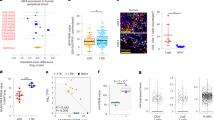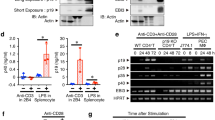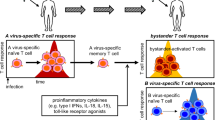Abstract
INFECTION of CD4+ T cells by human immune deficiency virus-1 (HIV-1) causes severe dysfunction of cellular immunity1–3, but paradoxically results in intense polyclonal activation of B cells, possibly accounting for both hypergammaglobulinaemia and frequent development of B-cell malignancies seen in HIV-infected patients4–7. We have reported that human CD4+ T-cell clones infected with HIV in vitro markedly stimulate immunoglobulin synthesis by B cells through a non-cognate, contact-dependent mechanism8. We show here that HIV-infected T-cell clones do not express the CD40 ligand (CD40L), a molecule critical for non-cognate B-cell activation9, but a small proportion of them do express membrane tumour-necrosis factor (TNF)-α. The ability of HIV-infected T-cell clones to induce polyclonal B-cell activation appears to be restricted to TNF-α-positive T blasts and is inhibited by antibodies against both TNF-α and TNF-α receptor. Freshly isolated CD4+ T cells from HIV-infected individuals express TNF-α on the cell membrane and induce TNF-α-mediated immunoglobulin production by B cells. Thus, membrane TNF-α seems to be involved in the polyclonal B-cell activation induced by HIV-infected T cells.
This is a preview of subscription content, access via your institution
Access options
Subscribe to this journal
Receive 51 print issues and online access
$199.00 per year
only $3.90 per issue
Buy this article
- Purchase on Springer Link
- Instant access to full article PDF
Prices may be subject to local taxes which are calculated during checkout
Similar content being viewed by others
References
Lane, H. C. et al. New Engl. J. Med. 313, 79–84 (1985).
Fahey, J. L. et al. Am. J. Med. 76, 95–100 (1984).
Bowen, D. L., Lane, H. C. & Fauci, A. S. Ann Intern. Med. 103, 704–709 (1985).
Amman, A. J. et al. Clin. Immun. Immunopath. 27, 315–325 (1983).
Euler, H. H., Kern, P., Loffler, H. & Dietrich, M. Clin. exp. Immun. 59, 267–275 (1985).
Kopelman, R. G. & Zolla-Pazner, S. Am. J. Med. 84, 82–88 (1988).
Lane, H. C. et al. New Engl. J. Med. 309, 453–458 (1983).
Macchia, D. et al. J. Immun. 146, 3413–3418 (1991).
Armitage, R. J. et al. Nature 357, 80–82 (1992).
Kinkhabwala, M. et al. J. exp Med. 171, 941–946 (1990).
Terpstra, F. G. et al. Eur. J. Immun 19, 667–673 (1989).
Pantaleo, G. et al. Nature 362, 355–358 (1993).
Embretson J. et al. Nature 362, 359–362 (1993).
Amadori, A. & Chieco-Bianchi, G. Immun. Today 11, 374–379 (1990).
Shalaby, M. R. et al. J. exp. Med. 172, 1517–1520 (1990).
Parronchi, P. et al. Proc. natn. Acad. Sci. U.S.A. 88, 4538–4593 (1991).
Kulczycki, A. & Metzgzer, H. J. exp. Med. 140, 1676–1685 (1974).
Author information
Authors and Affiliations
Rights and permissions
About this article
Cite this article
Macchia, D., Almerigogna, F., Parronchi, P. et al. Membrane tumour necrosis factor-α is involved in the polyclonal B-cell activation induced by HIV-infected human T cells. Nature 363, 464–466 (1993). https://doi.org/10.1038/363464a0
Received:
Accepted:
Issue Date:
DOI: https://doi.org/10.1038/363464a0
This article is cited by
-
Viral subversion of B cell responses within secondary lymphoid organs
Nature Reviews Immunology (2018)
-
Deficit of IgG2 in HIV-positive pregnant women is responsible of inadequate IgG2 levels in their HIV-uninfected children in Malawi
Medical Microbiology and Immunology (2018)
-
The multifaceted roles of TRAFs in the regulation of B-cell function
Nature Reviews Immunology (2004)
-
Expression of TNF and TNF Receptors (p55 and p75) in the Rat Brain after Focal Cerebral Ischemia
Molecular Medicine (1997)
-
The Cd40 ligand
Immunologic Research (1997)
Comments
By submitting a comment you agree to abide by our Terms and Community Guidelines. If you find something abusive or that does not comply with our terms or guidelines please flag it as inappropriate.



